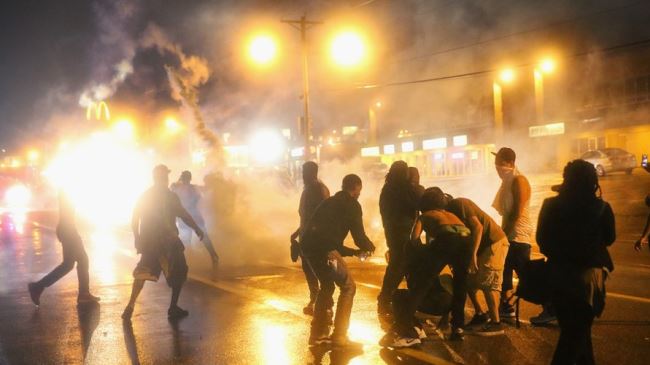Beyond Ferguson, Time for a black intifada?: Analyst

The shooting of the unarmed young Black American, Michael Brown, in the St. Louis, Missouri suburb of Ferguson by white police officer Darren Wilson triggered widespread protests against what appears to have become a commonplace event in the United States. Yet the failure by a grand jury to indict the shooter not only has highlighted the grotesque parody of due process of law in America, but also has revived the question of whether justice for African Americans can even be possible from within the existing US legal and political systems.
The United States of America is a country founded on racism; slavery was protected by the constitution. “The Migration or Importation of such Persons as any of the States now existing shall think proper to admit, shall not be prohibited by the Congress prior to the Year one thousand eight hundred and eight,” states Article 1 Section 9. The United States is also land of irony and contradiction, the most poignant example of which is its abysmal human rights record in the treatment of Blacks, most of whom were brought to the country against their will as slaves but nevertheless continued to live, work, fight and die for their rights as human beings.
When Thomas Jefferson wrote the electrifying words of the US Declaration of Independence in 1776, “We hold these truths to be self-evident, that all men are created equal, that they are endowed by their Creator with certain unalienable Rights,” he certainly did not intend them to apply to Blacks for he himself was a slave owner, as were eleven other US presidents. The first president, George Washington, owned over 200, and the last president to own slaves was Ulysses S. Grant, a former general during the American Civil War on the Union side, which allegedly was fighting to rid the country of the scourge of slavery.
Ironically, the first martyr in the American Revolution was an escaped slave from Massachusetts named Crispus Attucks, who rallied the weak-willed colonists to fight against British regulars in what later became known as the Boston massacre. The gallantry of the Black soldiers at the Battle of Bunker Hill so alarmed George Washington and his fellow white racist officers, that they forbade further enlistment of Blacks into their ranks for fear that the British army might do the same. But when the deposed royal governor of Virginia, Lord Dunmore, offered Black slaves freedom if they would fight on the British side, Washington reversed his position.
It is impossible to fathom the anger and frustration of Blacks in the US without looking into the history of their valiant struggle to gain freedom and rights as equals. In 1860, just before the outbreak of the Civil War, there were nearly 4 million enslaved Blacks laboring under abominable conditions that should have been an affront to any human being. In addition to enduring the institutionalized indignities of the dawn-to-dusk forced labor, brutal discipline and squalid living conditions, Black families were routinely destroyed at the whims of their white masters who separated daughters from mothers and sons from fathers when sold like cattle at slave auctions. Black children were wrenched from childhood and forced into the fields at age six or seven; by ten they were tasked with the labor of an adult. In short, Blacks in America were denied their inalienable human rights and suffered every imaginable indignity.
While US school children are taught that Abraham Lincoln freed the slaves, in truth he manipulated the slavery issue for political advantage. That he was a racist is clear from his initial meetings in 1862 with Black leaders, whom he informed in no uncertain terms that it was their duty to leave America. Proposing the establishment of a Black colony on land in Central America, under white leadership of course, Lincoln said, “You and we are different races. We have between us a broader difference than exists between almost any two other races. … It is better for us both … to be separated.” As late as April 1865, just before the end of the war, Lincoln was still considering mass deportation of “freed” Blacks, but finally gave up on the idea due to the inadequacy of available means of transport.
The much lauded Emancipation Proclamation signed by Lincoln on January 1, 1863 only freed slaves in those Confederate states that were still in rebellion and not yet occupied by Union troops; the document actually served to continue the enslavement of over 500,000, far more than it ever freed. Whether intended by Lincoln or not, some 100,000 of the Blacks freed by the proclamation joined the Union army to fight against the Confederacy and its institutionalized slavery, but even as Union soldiers, the Blacks were insulted with monthly pay of seven dollars, barely more than half the thirteen dollars paid monthly to the white Union troops.
After the Civil War, the US Congress passed three constitutional amendments that were intended to establish the rights of the newly created Black citizens and punish the rebellious Confederates: the Thirteenth Amendment abolished slavery, the Fourteenth established a modicum of civil rights and the Fifteenth prohibited denial of voting rights on account of race. While giving the appearance of progress, in practice the amendments served as legal cover for white racist legislators, who reinforced segregation and discrimination against Blacks under the so-called Jim Crow laws.
For its part, the US Supreme Court rejected every opportunity to rule against the legalized disenfranchisement of Blacks. In a famous case in 1896, Plessy v. Ferguson, the Supreme Court upheld the constitutionality of an 1890 Louisiana law that required railway companies to provide “equal but separate accommodations for the white and colored races.” In delivering the majority opinion, Justice Henry Billings Brown wrote regarding the law, “That it does not conflict with the Thirteenth Amendment, which abolished slavery and involuntary servitude, except as a punishment for crime, is too clear for argument.”
In another case, Berea College v. Kentucky in 1908, the Supreme Court ruled that a 1904 Kentucky law prohibiting a person or corporation from holding racially mixed classes was not unconstitutional. Moreover, Justice David Josiah Brewer in the majority opinion, with Justice Oliver Wendell Holmes concurring, wrote that “when a state court decides a case upon two grounds, one federal and the other nonfederal, this Court will not disturb the judgment if the nonfederal ground, fairly construed, sustains the decision.” This effectively condoned bigoted state laws, as Justice John Marshall Harlan pointed out in his dissent, since “a state may make it a crime for white and colored persons to frequent the same marketplaces at the same time.”
By 1906, Black resistance groups had formed due to the intolerable conditions, which were rapidly becoming enshrined in the US with the Jim Crow laws. One resistance group formed by activist scholar W.E.B. Du Bois, the Niagara militants, demanded an end to segregation and discrimination. “We want the laws enforced against rich as well as poor; against capitalists as well as laborers; against white as well as Black,” they insisted, demanding also enforcement of the previously mentioned constitutional amendments. Their reasonable demands, which stand unfulfilled to this day, were met by angry white mobs that carried out massacres in Atlanta, Georgia and Springfield, Illinois, Abraham Lincoln’s birthplace.
With homeland hysteria running rampant among white Americans while Black Americans fought overseas under French command, race riots broke out in East St. Louis, not far from Ferguson where Michael Brown was slain. On July 2, 1917, white racists angered by the employment of Blacks, killed up to two hundred people and drove six thousand from their homes. Lynchings and other sadistic acts of barbarism against Blacks became all too common. By the end of World War One, contrary to President Wilson’s eloquent rhetoric, not only was America not safe for democracy, it was downright lethal for Blacks demanding their rights.
By the time of the Great Depression, conditions for Blacks had deteriorated even further: one third of Blacks were unemployed, two thirds of the Blacks in Atlanta were on relief and ten cents an hour was the going labor rate for Black men. Not surprisingly, Black separatist movements, such as Oscar C. Brown’s 49th State movement and Elijah Muhammad’s Nation of Islam, began to grow as did the idea of not finding a solution to the dilemma within the white American political structure. Even scholars like W.E.B. Du Bois began considering the idea of Black separation as the antidote for the unending racial oppression by whites.
As another world war pressured the US government to ban discrimination in the armaments industry, once again white mobs rioted in several cities in 1943. When World War Two ended without significant social progress, Blacks took their case to the newly formed United Nations in 1947. While the move pushed President Truman to name a civil rights committee, no tangible improvement in the lives of African Americans resulted. However in 1954 when the Supreme Court ruled “separate but equal” education was unconstitutional in the landmark case Brown v. Board of Education, hopes rose that conditions might improve for Blacks in America.
Throughout the following decade, great leaders like Dr. Martin Luther King, Malcom X, Medgar Evers, Ralph Abernathy and Stokely Carmichael inspired Blacks to join in dissent against American apartheid policies that defied change. Protesting segregation in restaurants, schools and public transit systems by sit-ins, demonstrators risked attack by white racists and police armed with tear gas, clubs, whips and cattle prods. Many, including Dr. King, Malcom X and Medgar Evers, were killed, but their efforts culminated in the passage of the Civil Rights Act of 1964, which outlawed certain discriminatory practices in voting registration, public accommodations, public schools and employment. This marked the first time since the Civil War that the US Congress passed a major law to protect minority rights, but not before West Virginia Senator and former Ku Klux Klan member Robert Byrd spoke for 14 hours straight, the final speech in a 75-day filibuster by racist senators who were determined to block its passage.
Some 50 years have passed since US President Lyndon Baines Johnson signed the Civil Rights Act into law, yet circumstances for Blacks have only worsened due to the deeply embedded racism as seen by the acquittal of Darren Wilson, the slayer of Michael Brown. By most any measure—financial, unemployment, education, housing, social or medical—Blacks in the US are worse off today than they were in the 1960s.
As a consequence of the repeated killings of Blacks, as has again occurred in Ferguson, white Americans have made the path for peaceful change impossible, thus making violent revolution inevitable. Blacks have few options against the US apartheid regime but the paths of popular and armed resistance, as taken by their Palestinian brothers and sisters against the Israeli entity. To go beyond Ferguson, it is time for a Black intifada.







